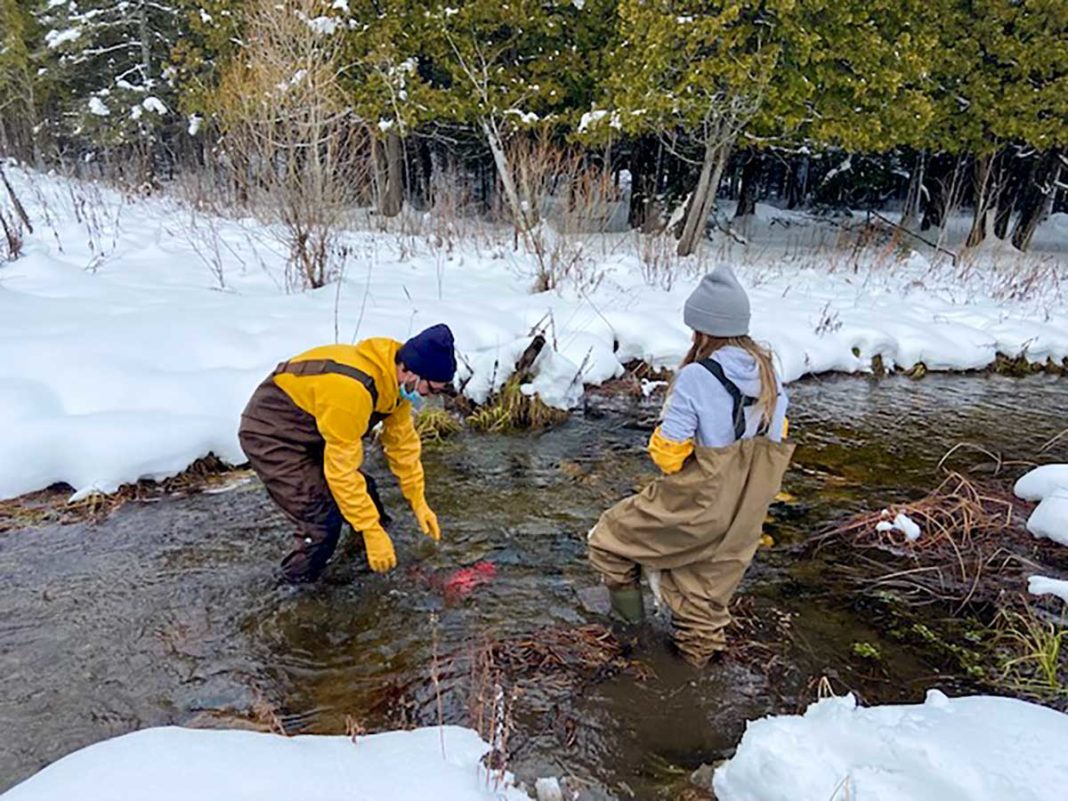ASSIGINACK – A hardy and determined group of volunteers from the Little Current Fish and Game Club and Manitoulin Streams gathered with strict COVID-safe distancing to ensure that this year’s brook trout eyed-egg event went over without a hitch.
Manitoulin Streams project co-ordinator Seija Deschenes estimated that there were approximately 20 volunteers onsite at the Assiginack arena to load the “Scotty boxes” with 10,000 fertilized brook trout eggs to be placed in Norton’s Creek.
“It was a shame that we couldn’t have the students out we normally have for this event,” she said, “but with the rising numbers on the Island, the need for everyone to be double vaccinated and to have proof of vaccination, it was just too much to be able to put together. Hopefully, fingers crossed, we can have the students here again.”
The eggs come from the Hill’s Lake hatchery near Englehart, explained Ms. Deschenes. “They have been great,” she said. “They brought the eggs right to my house to avoid the Christmas tie-ups in shipping.” The issue of the eggs arriving late has happened in the past, she noted.
This latest batch of eyed eggs (so-called because the eyes of the tiny brook trout are visible in the eggs when they are transplanted) will bring the total planted in the frigid waters of Norton’s Creek to a cool 90,000 since the program began.
Ms. Deschenes explained that the eggs are carefully seeded into the many tiny chambers of the Scotty boxes (in-stream incubators) before being placed in the stream and a large rock wedged on top to keep them in place. “There are some small eggs that don’t stay in the tubes,” she said, “so we gather them up from the bottom of the plate and sprinkle them over top of the box in the stream.” Nothing goes to waste.
Clean spawning gravel is then sprinkled around the boxes. “When the eggs hatch, they still have an egg sac attached to them,” explained Ms. Deschenes. “They live off the egg sac until they grow large enough to swim out.” That is where the gravel plays its role.
“The fingerlings burrow down into the gravel, where they are protected from predators for longer,” she said. “It helps increase the survival rate.” When the eggs hatch naturally, the egg sac causes them to float, making the fry very vulnerable to predation.
The eggs come from the Nipigon Lake stream base and are well-suited to the waters of the Island’s streams.
Volunteers Liam Campbell and Maylen Moffatt took on the cooler task of placing the boxes carefully in the stream so that the water flows through the tubes.
“We have to shout out a huge thanks to all of our volunteers who did an amazing job again this year,” said Ms. Deschenes. “The weather really cooperated. It was like -19°C the day before and above zero and sunny when we went to put the boxes in the stream.”
It has been nearly a decade that the eyed-egg event has been hosted by Manitoulin Streams and their determination is beginning to pay off.
“It was wonderful to see fully matured brook trout in the creek when it was electofished in the fall,” said Ms. Deschenes. “It shows that we have many different age classes in the stream now.” Those different age classes suggest that natural replenishment is starting to take place.




